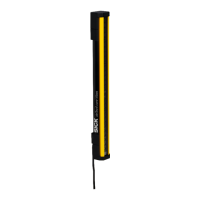16 List of figures
1. Sender and receiver................................................................................................... 10
2. Device overview.......................................................................................................... 11
3. Sender displays...........................................................................................................12
4. Receiver displays........................................................................................................ 12
5. Hazardous point protection........................................................................................13
6. Access protection....................................................................................................... 13
7. Hazardous area protection.........................................................................................14
8. Minimum distance to the hazardous point for orthogonal (rectangular) approach
t
o the protective field..................................................................................................18
9. Representation of the accessibility of ESPE by reaching over. Left: Protective field
that cannot be reached over. Right: Protective field that can be reached over......19
10. Minimum distance from reflective surfaces............................................................. 19
11. Graph of minimum distance from reflective surfaces............................................. 20
12.
Preventing mutual interference from system1 and s
ystem2..............................21
13.
Trouble-free operation due to reversed direction of transmission of system1 and
s
ystem2.................................................................................................................... 22
14. Trouble-free operation with sufficient distance........................................................ 22
15. Fault-free operation by changing the direction and sufficient distance................. 23
16. Dual-channel and isolated connection of OSSD1 and OSSD2................................24
17. No potential difference between load and protective device.................................. 24
18. Schematic representation of operation with restart interlock.................................26
19. Connection diagram for RLY3-OSSD2 with restart interlock and external device
monit
oring................................................................................................................... 27
20. Test rod check: Step 1................................................................................................30
21. Test rod check: Step 3................................................................................................30
22. Sender and receiver must not be installed such that they are rotated 180° relative
to each other...............................................................................................................33
23. Mounting the QuickFix bracket to a profile............................................................... 37
24. Dual-channel and isolated connection of OSSD1 and OSSD2................................39
25. No potential difference between load and protective device.................................. 39
26. System connection (male connector, M12, 5-pin)................................................... 39
27. QuickFix bracket: adjust vertically............................................................................. 43
28. Dimensional drawing of sender and receiver........................................................... 55
29. Dimensional drawing of the QuickFix bracket.......................................................... 59
LIST OF FIGURES 16
8024467/1GWF/2022-11-11 | SICK O P E R A T I N G I N S T R U C T I O N S | deTec4 Core Vibes
65
Subject to change without notice

